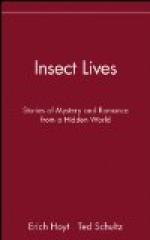when the larva lurks in its hiding place, or be suddenly
darted out so as to secure any unwary small insect
that may pass close enough for capture. Dragon-fly
larvae walk, and also swim by movements of the abdomen
or by expelling a jet of water from the hind-gut.
The walls of this terminal region of the intestine
have areas lined with delicate cuticle and traversed
by numerous air-tubes, so that gaseous exchange can
take place between the air in the tubes and that dissolved
in the water. The larvae of the larger and heavier
dragon-flies (Libellulidae and Aeschnidae) breathe
mostly in this way. Those of the slender and delicate
‘Demoiselles’ (Agrionidae) are provided
with three leaf-like gill-plates at the tail, between
whose delicate surfaces numerous air-tubes ramify.
These gill-plates are at times used for propulsion.
Thus air supply is ensured during aquatic life.
But occasionally, when the water in which the larva
lives is foul and poor in oxygen, the tail is thrust
out of the water so that air can be admitted directly
into the intestinal chamber. The aquatic life
of these insects lasts for more than a year, and F.
Balfour-Browne (1909) has observed from ten to fourteen
moults in Agrion. Outward wing-rudiments are
early visible on the thoracic segments; when these
have become conspicuous the insect, beginning in some
respects to approach the adult condition, is often
called a nymph. In an advanced dragon-fly nymph,
H. Dewitz (1891) has shown that the thoracic spiracles
are open, and, as the time for its final moult draws
near, the insect may thrust the front part of its body
out of the water, and breathe atmospheric air through
these. Thus before the great change takes place
the nymph has foretastes of the aerial mode of breathing
which it will practise when the perfect stage shall
have been attained. The emergence of the dragon-fly
from its nymph-cuticle has been described by many
naturalists from de Reaumur (1740) to L.C. Miall
(1895) and O.H. Latter (1904). The nymph
climbs out of the water by ascending some aquatic
plant, and awaits the change so graphically sketched
by Tennyson:
A hidden impulse rent the
veil,
Of his old husk, from head
to tail,
Came out clear plates of sapphire
mail.
‘From head to tail,’ for the nymph-cuticle
splits lengthwise down the back, and the head and
thorax of the imago are freed from it (fig. 8 a),
then the legs clasp the empty cuticle, and the abdomen
is drawn out (fig. 8 b, c). After a short
rest, the newly-emerged fly climbs yet higher up the
water-weed, and remains for some hours with the abdomen
bent concave dorsalwards (fig. 8 d), to allow
space for the expansion and hardening of the wings.
For some days after emergence the cuticle of the dragon-fly
has a dull pale hue, as compared with the dark or
brightly metallic aspect that characterises it when
fully mature. The life of the imago endures but
a short time compared with the long aquatic larval
and nymphal stages. After some weeks, or at most
a few months, the dragon-flies, having paired and
laid their eggs, die before the approach of winter.




